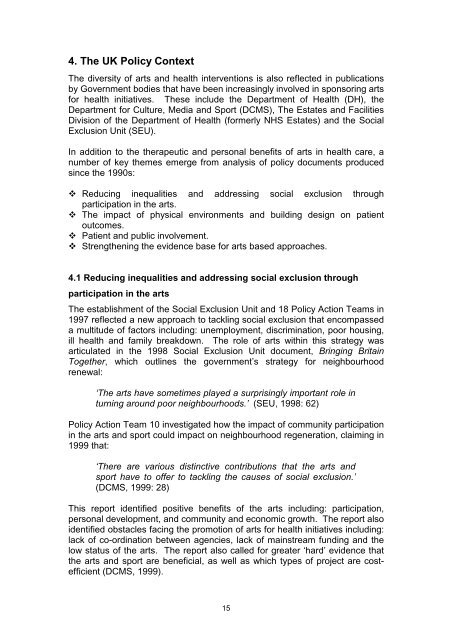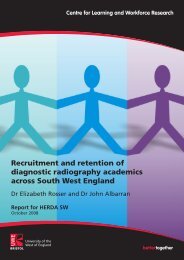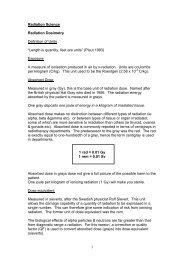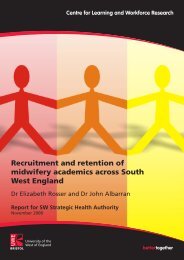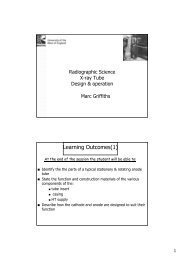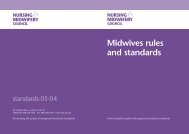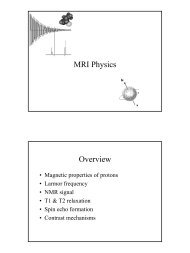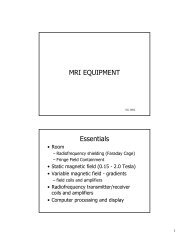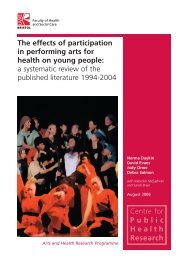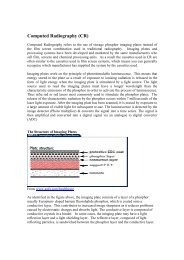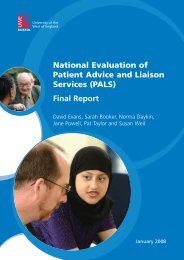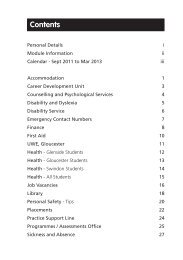Literature Review - HSC Home - University of the West of England
Literature Review - HSC Home - University of the West of England
Literature Review - HSC Home - University of the West of England
Create successful ePaper yourself
Turn your PDF publications into a flip-book with our unique Google optimized e-Paper software.
4. The UK Policy ContextThe diversity <strong>of</strong> arts and health interventions is also reflected in publicationsby Government bodies that have been increasingly involved in sponsoring artsfor health initiatives. These include <strong>the</strong> Department <strong>of</strong> Health (DH), <strong>the</strong>Department for Culture, Media and Sport (DCMS), The Estates and FacilitiesDivision <strong>of</strong> <strong>the</strong> Department <strong>of</strong> Health (formerly NHS Estates) and <strong>the</strong> SocialExclusion Unit (SEU).In addition to <strong>the</strong> <strong>the</strong>rapeutic and personal benefits <strong>of</strong> arts in health care, anumber <strong>of</strong> key <strong>the</strong>mes emerge from analysis <strong>of</strong> policy documents producedsince <strong>the</strong> 1990s: Reducing inequalities and addressing social exclusion throughparticipation in <strong>the</strong> arts. The impact <strong>of</strong> physical environments and building design on patientoutcomes. Patient and public involvement. Streng<strong>the</strong>ning <strong>the</strong> evidence base for arts based approaches.4.1 Reducing inequalities and addressing social exclusion throughparticipation in <strong>the</strong> artsThe establishment <strong>of</strong> <strong>the</strong> Social Exclusion Unit and 18 Policy Action Teams in1997 reflected a new approach to tackling social exclusion that encompasseda multitude <strong>of</strong> factors including: unemployment, discrimination, poor housing,ill health and family breakdown. The role <strong>of</strong> arts within this strategy wasarticulated in <strong>the</strong> 1998 Social Exclusion Unit document, Bringing BritainToge<strong>the</strong>r, which outlines <strong>the</strong> government’s strategy for neighbourhoodrenewal:‘The arts have sometimes played a surprisingly important role inturning around poor neighbourhoods.’ (SEU, 1998: 62)Policy Action Team 10 investigated how <strong>the</strong> impact <strong>of</strong> community participationin <strong>the</strong> arts and sport could impact on neighbourhood regeneration, claiming in1999 that:‘There are various distinctive contributions that <strong>the</strong> arts andsport have to <strong>of</strong>fer to tackling <strong>the</strong> causes <strong>of</strong> social exclusion.’(DCMS, 1999: 28)This report identified positive benefits <strong>of</strong> <strong>the</strong> arts including: participation,personal development, and community and economic growth. The report alsoidentified obstacles facing <strong>the</strong> promotion <strong>of</strong> arts for health initiatives including:lack <strong>of</strong> co-ordination between agencies, lack <strong>of</strong> mainstream funding and <strong>the</strong>low status <strong>of</strong> <strong>the</strong> arts. The report also called for greater ‘hard’ evidence that<strong>the</strong> arts and sport are beneficial, as well as which types <strong>of</strong> project are costefficient(DCMS, 1999).15


